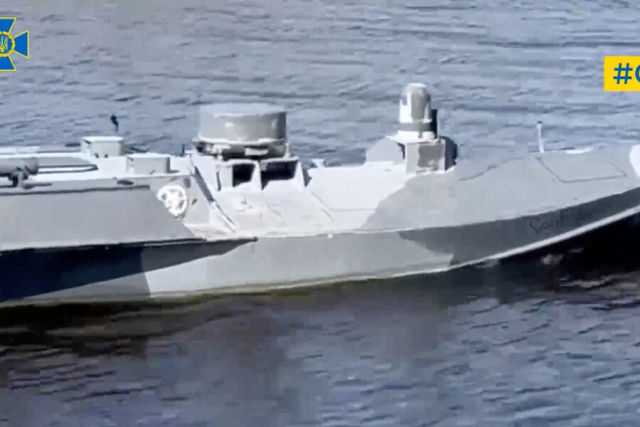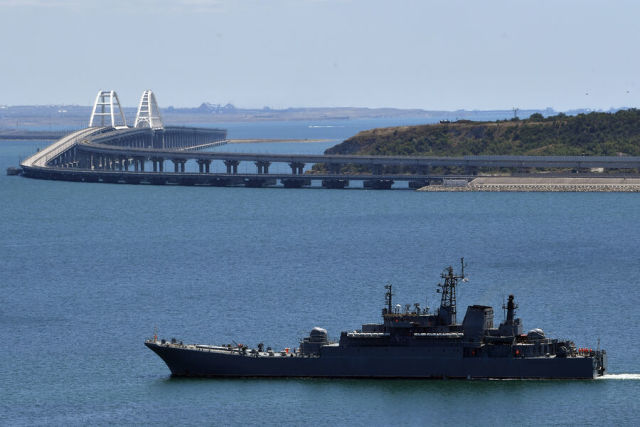Colonel Khodarenok urged to prepare for the massive use of marine drones
Recently, Ukraine has used unmanned boats against Russian ships, vessels and objects in the Black Sea. Observers in the West believe that this has begun a new era in the war on the seas and oceans. Whether this is really the case and whether it is worth talking about the departure of traditional naval battles into the past, the military observer of "Gazeta.En" Mikhail Khodarenok.
The combat use of such means of attack has become a very alarming signal for the naval forces of many States. The armed struggle on the seas and oceans is on the threshold of a new era based on unmanned surface and underwater platforms and systems, according to Defense News..
Unmanned boats were one of the factors that influenced the decision of IISS (The International Institute for Strategic Studies, International Institute for Strategic Studies) to include such capabilities in their military databases for the first time. According to Defense News, Ukraine has demonstrated that it is possible to use relatively modest technologies quickly enough and turn them into an effective weapon system at very moderate financial costs.
Ukraine's use of these weapons against Russian ships in their bases has certainly prompted the naval forces of many States to reconsider many measures for the protection and defense of naval bases and ports. In a sense, the Ukrainian attacks are the modern equivalent of the fire-ships of the times of the sailing fleet. But there are other lessons that, according to Western experts, should be learned from the experience of combat use of unmanned boats.
Naval forces of many states are currently developing ways to combat massive attacks by unmanned high-speed boats. At the same time, some measures to combat such means of attack may eventually turn out to be quite simple. For example, the most effective means may be the surface ships themselves, equipped with appropriate means of reconnaissance and rapid-fire melee weapons.
A significant disadvantage of any unmanned boat is the surface part of a very considerable geometric dimensions. For these reasons, it can be relatively easily detected on the sea surface by radar stations (including those equipped with an optical channel). Among other things, a marine drone, even at relatively long ranges, is easily detected by visual observation posts.
By definition, there is no armor protection of vital units on ships of this type. Therefore, unmanned boats are relatively easily hit by small-gun fire. For example, large-caliber machine guns of 12.7 and 14.5 mm caliber, as well as naval artillery installations AK-630 of 30 mm caliber with one six-barrel rotating gun. At the same time, as a rule, there is a detonation of the warhead of an unmanned boat, which literally blows the marine drone to pieces.
Among other things, the control of an unmanned boat can be paralyzed by means of electronic warfare. The marine drone is guided by the operator using radio commands. A satellite signal is used to solve navigation problems. Therefore, the staging of organized interference is quite possible.
As for the defense of infrastructure facilities at sea (bridge crossings and naval bases), then, as the newspaper previously wrote .Ru", in this regard, traditional and long-known bonoset barriers and sea mines can be used to combat unmanned boats. And these funds will clearly be among the most effective. Therefore, it is not worth considering unmanned boats as some kind of invulnerable superweapon at sea.
However, in general, interest in unmanned systems at sea (both offensive and defensive) is increasing every day. They are increasingly appearing in the order portfolios of many defense companies and are shown at exhibitions of weapons and military equipment around the world.
Currently, according to Defense News, much broader transformations are taking place in this area, including large-scale work on unmanned, semi-autonomous and autonomous systems at sea.
They include almost everything: from surveillance (reconnaissance) and data collection to the combat operations of the corresponding platforms both on the surface of the sea and under water. For example, with the help of marine drones, it is supposed to provide stable barrier protection against enemy submarines, since there are too few high-class manned platforms for solving such tasks. Perhaps this will change submarine warfare in general. The struggle of unmanned vehicles with minefields is also important.
and it can become an attractive place for the use of such technologies. The attacks on the Nord Stream were another wake-up call, highlighting the lack of capabilities to monitor and protect critical underwater infrastructure.
There is an urgent need to turn the potential of unmanned systems at sea into a new reality of conducting an armed struggle at sea, Defense News is confident. And one can certainly agree with this point of view. In this sense, the events in the Black Sea are a kind of bifurcation point, because now the focus is on both opportunities and problems associated with these technologies.

SBU marine drone "Sea Baby"
Image source: Security Service of Ukraine/Reuters
Many experts in the field of shipbuilding and armed struggle at sea are already asking questions today: will the traditional forms and methods of using naval fleets - naval and naval operations - become part of history in the near future, will the construction of large-displacement ships of the cruiser class be relevant?
Apparently, it is still somewhat premature to talk about the imminent end of the era of traditional naval battles at this stage, but the situation on the seas and oceans currently resembles the appearance of a large number of UAVs and the capabilities of traditional air defense to combat them. In other words, in the near future, the winning side will certainly be the one that is better prepared for the massive use of unmanned systems and platforms at sea. The first call about the upcoming beginning of this era has already sounded.
The opinion of the author may not coincide with the position of the editorial board.
Biography of the author:
Mikhail Mikhailovich Khodarenok is a military columnist for the newspaper.Ru", retired colonel.
He graduated from the Minsk Higher Engineering Anti-Aircraft Missile School (1976), the Military Air Defense Command Academy (1986).
Commander of the S-75 anti-aircraft missile division (1980-1983).
Deputy Commander of the anti-aircraft missile regiment (1986-1988).
Senior Officer of the General Staff of the Air Defense Forces (1988-1992).
Officer of the Main Operational Directorate of the General Staff (1992-2000).
Graduated from the Military Academy of the General Staff of the Armed Forces of Russia (1998).
Columnist of "Nezavisimaya Gazeta" (2000-2003), editor-in-chief of the newspaper "Military-Industrial Courier" (2010-2015).
Mikhail Khodarenok

